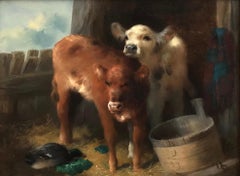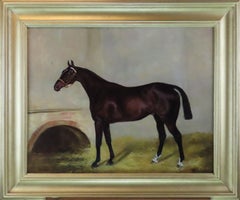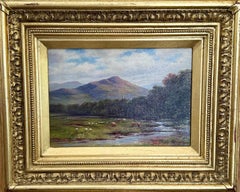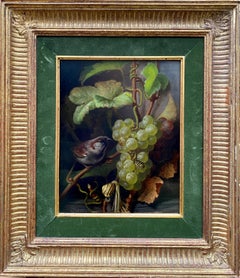Late 19th Century Animal Paintings
to
44
82
46
61
39
35
Overall Width
to
Overall Height
to
148
817
1,770
6,033
61
35
53
56
59
90
125
127
144
164
102
25
3
3
1
187
74
2
121
89
66
48
43
40
31
30
27
27
24
20
17
15
12
10
9
8
8
8
258
251
117
115
26
4
3
3
2
2
221
12
176
87
Period: Late 19th Century
Barnyard Scene, Original Oil Painting
By George William Horlor
Located in Naples, Florida
George William Horlor (British 1819-1899)
George William Horlor was born in Bath around 1819. He married Mary Cook on 15 March 1845 and by 1851 was living in Cheltenha...
Category
Romantic Late 19th Century Animal Paintings
Materials
Oil
$6,120 Sale Price
20% Off
Original Oil on Canvas, Margaret Collyer. "Father O'Flynn"
Located in Mere, GB
Margaret Collyer, (1872 - 1945). A London painter of animal scenes, whether horse portraits or dramatic highland scenes such as her "Lord of the Isles". She exhibited at the Royal Ac...
Category
Late 19th Century Animal Paintings
Materials
Oil
Country Tranquility Cattle and Sheep Crossing a Stream in a Peaceful Landscape
Located in Cirencester, Gloucestershire
Country Tranquility
English School, late 19th century
oil on canvas, framed
Framed: 17.5 x 21.5 inches
Canvas: 12 x 16 inches
Provenance: private collection, UK
Condition: very good ...
Category
Victorian Late 19th Century Animal Paintings
Materials
Oil
19th century British Sheep and Cows in Landscape of Upper Airedale, Yorkshire UK
Located in Woodbury, CT
J. Charnock
“Upper Airedale, Yorkshire”
Oil on board, signed lower right
English, circa 1890
Presented in a richly carved and gilded period frame
This idyllic pastoral scene by the ...
Category
Victorian Late 19th Century Animal Paintings
Materials
Oil, Board
Highland Cattle in a Mountain Glen, original oil on canvas, 19thC British
Located in Naples, Florida
This is a stunning artwork entitled a ‘Landscape with Highland Cattle’. It is circa 20th Century and is an original oil on canvas painting by the English Artist William Perring Holly...
Category
Realist Late 19th Century Animal Paintings
Materials
Canvas, Oil
A Still Life with Sparrow and Grapes, Artist 19th century, European School
Located in Knokke, BE
A Still Life with Sparrow and Grapes
Artist 19th century
European School
Signature: Verso signed and dated 1883
Medium: Oil on panel
Dimensions: Image size 23 x 18 cm, frame size 3...
Category
Realist Late 19th Century Animal Paintings
Materials
Oil, Wood Panel
John Appleton Brown ( American, 1844-1902 ) Animal Pastel
Located in New York, NY
Medium: Pastel
Style: Animal
Painting Size: 19.5 x 15.5 inches
Frame Size: 31.5 x 25.5 inches
Condition: This artwork is in good condition for its age.
Signature: Hand-signed
Artis...
Category
Late 19th Century Animal Paintings
Materials
Pastel
Portrait of "Cablefoot" Champion Greyhound, 19th Century by George PAICE
By George Paice
Located in Blackwater, GB
Portrait of "Cablefoot" Champion Greyhound, 19th Century
by George PAICE (1854-1925) to $15,000
19th century portrait of Cablefoot a champion racing greyhound, oil on canvas by Geo...
Category
Late 19th Century Animal Paintings
Materials
Canvas, Oil
Dog Portraits: "The Musicians" Charles Van den Eycken ((1859 - 1923)
By Charles H. Van den Eycken
Located in SANTA FE, NM
"The Musicians"
Charles H. Van den Eycken (Belgium, 1859 - 1923)
Oil on wood panel with highly ornate original wood, stucco and gilt frame.
Signed upper right and dated "1893.'
10 1...
Category
Realist Late 19th Century Animal Paintings
Materials
Oil, Mahogany, Wood Panel
Antique American Fluffy Pomeranian Dog Portrait Wide Gold Frame Oil Painting
Located in Buffalo, NY
Incredible signed early American dog portrait painting. Oil on board. Signed. Housed in a period gold giltwood frame.
Category
Realist Late 19th Century Animal Paintings
Materials
Canvas, Oil
$1,980 Sale Price
20% Off
Victorian English Dog Painting Oil on Canvas Head Portrait of Terrier
Located in Cirencester, Gloucestershire
Head Portrait of a Terrier Dog
by W. Mitchell (English, late 19th Century)
oil on canvas, unframed
canvas: 12 x 10 inches
provenance: private collection, UK
condition: very good and ...
Category
Victorian Late 19th Century Animal Paintings
Materials
Oil, Canvas
André Plumot, 1829 – 1906, Shepherds Couple with Herd in a River Landscape
Located in Knokke, BE
Plumot André
Antwerp, Belgium 1829 – 1906
Belgian Painter
Shepherds Couple with Herd in a River Landscape
Signature: Signed bottom left and dated 1877
Medium: Oil on canvas
Dimensions: Image size 58,50 x 104,50 cm
Biography: Plumot André (Plumot Andre) was born on February 10, 1829 in Antwerp, Belgium.
He was a painter of genre scenes, interiors, animals, children and figures. In general, he painted interiors in 16th-17th century style.
He was a student at the Academy of Fine Arts of Antwerp under master teacher and artist H. Van der Poorten.
For a short time, he worked in N. de Keyser...
Category
Romantic Late 19th Century Animal Paintings
Materials
Canvas, Oil
Afternoon Ride, Pair of Equestrian Landscape Paintings of Horses with Riders
Located in Doylestown, PA
Afternoon ride is a pair of, 13 x 9 inches each, equestrian paintings by Pennsylvania painter James N Hess. One is signed in the lower left, one is signed in the lower right.
Animal...
Category
American Realist Late 19th Century Animal Paintings
Materials
Oil, Board
HERMMANN LEON - Painting 19th Century - Portrait of a Dog in Interior
Located in Saint-Ouen, FR
HERRMANN LEON Charles (1838-1908)
Portrait of a Dog in interior
Oil on canvas signed low left
Old frame re-gilded with gold leaves
Dim canvas : 56 X 46 cm
Dim frame : 69 X 59 cm
HERRMANN LEON Charles (1838-1908)
French painter 19th century
Born 22 july 1838 in Le Havre. Died 1...
Category
Academic Late 19th Century Animal Paintings
Materials
Oil
A portrait of a black and white spaniel dog in a sumptuous interior
Located in Bath, Somerset
A black and white spaniel standing on a yellow silk damask covered day-bed in a sumptuous interior.
Provenance:
With Arthur Ackermann & Son Ltd., London.
Anonymous sale; Christie's, South Kensington, 15 May 2007, lot 284
Private collection, London
Samuel John Carter...
Category
English School Late 19th Century Animal Paintings
Materials
Canvas, Oil
Cat and Kitten on the Desk
Located in Saint-Ouen, FR
LE ROY Jules Gustave (1853 - 1922 )
Cat and Kitten on the Desk
Oil on canvas signed low left
Old Frame regilded with leaves
Dim canvas : 46 X 38 cm
Dim frame : 58 X 50 cm
LE ROY Jules Gustave (1853 - 1922 )
French painter 19th-20th century.
Jules Le Roy...
Category
Academic Late 19th Century Animal Paintings
Materials
Oil
The Belvoir, Checked
Located in Lexington, KY
Established in 1750 on the 15,000 acre Belvoir Estate in Leicestershire, England. The Belvoir Hunt, also known as the “Duke of Rutlands Hounds”, has a very long and rich history. The...
Category
Late 19th Century Animal Paintings
Materials
Oil
Antique Scottish Oil Highlands Loch Scene Cattle under Summer Clouds Landscape
Located in Cirencester, Gloucestershire
"Passing Clouds"
British School, late 19th century
indistinctly signed
oil painting on board, framed
framed: 14 x 18 inches
board: 10 x 13.5 inches
Provenance: Private collection, U...
Category
Victorian Late 19th Century Animal Paintings
Materials
Oil
English Native School, 19th Century, still life with fish
Located in Tricase, IT
English Native School, 19th Century, still life with fish
Oil on canvas 54x63 cm frame included.
Beautiful native English painting, representing an elegant still life of fish, cabba...
Category
English School Late 19th Century Animal Paintings
Materials
Canvas, Oil
Hunting Dog cubs , oil painting on canvas by Caspar Von Reth 19th c.
Located in Gavere, BE
Hunting Dog cubs , oil painting on canvas by Caspar Von Reth 19th c.
German animal and portrait painter and sculptor (1850 to 1913 Aachen).
Studied with A. Fischer in Aachen, Wolff...
Category
Late 19th Century Animal Paintings
Materials
Gold Leaf
Cats in interior
Located in Saint-Ouen, FR
LE ROY Jules Gustave (1853 - 1922 )
Cats in Interior
Oil on canvas signed low right
Old frame gilded with leaves
Size canvs : 41 X 33 cm Size frame : 51 x 63 cm
LE ROY Jules Gustave (1853 - 1922 )
19th-20th century - French painter
Jules Le Roy or Jules Leroy was born the 22th of December 1853. Dead in 1922 according to the Roubaix Museum
Wildlife artist.
He mainly painted cats...
Category
Academic Late 19th Century Animal Paintings
Materials
Oil
Antique Scottish Landscape Highland Cattle on Loch Pathway Mountains
Located in Cirencester, Gloucestershire
A Highland Landscape with Drover and Cattle
A. Lewis (19th - 20th Century)
signed oil painting on canvas, framed
framed: 22 x 30 inches
canvas: 12 x 20 inches
provenance: private col...
Category
Victorian Late 19th Century Animal Paintings
Materials
Oil
Teaching him a New Trick
Located in Mc Lean, VA
19th Century Dutch
Category
Academic Late 19th Century Animal Paintings
Materials
Canvas, Oil
A portrait of an English terrier dog standing in a walled garden, signed.l
By John Emms
Located in Bath, Somerset
A terrier named Joe standing in an English country house walled garden, painted by the eminent animal painter John Emms (1844-1912) in the late 19th cent...
Category
English School Late 19th Century Animal Paintings
Materials
Oil, Canvas
Swans in the Park, Hans Volcker, Pyrzyce, Poland 1865 – 1944 Wiesbaden, Germany
Located in Knokke, BE
Swans in the Park
Volcker Hans
Pyrzyce, Poland 1865 – 1944 Wiesbaden, Germany
German Painter
Signature: Signed bottom left and dated 98
Medium: Oil on canvas
Dimensions: Image size 72 x 111,50 cm, frame size 84 x 120 cm
Biography: Volcker Hans was born on October 12, 1865 in Pyrzyce, Poland. Hans was the son of a pastor, orphaned at a young age and raised by his grandfather.
Hans Volcker was a painter of landscapes, seascapes, still lives and portraits. He also painted in watercolour and fresco techniques.
In 1885, Volcker was a student of famed Norwegian realist painter Hans Fredrik Gude (1825 – 1903) at the Berlin Academy. His teacher encouraged him to travel to Scandinavia. During his study trips, he made landscape paintings of Scandinavian mountain and lakes, that brought him later great recognition.
In 1891, he led his own plein air painting school. The most famous pupils were german sculptor and painter Margarethe Haeffner (1884 – 1977) and the painter Oskar Moll (1875 – 1947).
With his Berlin friend painter Walter Leistikow (1865 – 1908), who was also a pupil of Gude, he shared an admiration for Max Liebermann (1847 – 1935). His acquaintance with Liebermann’s paintings furthered his stylistic development to an Impressionism.
In 1894 he lived in Munich and moved to Wiesbaden in 1899, where he was active as a contemporary artist and as a member of the Art Societies, presenting Max Liebermann, Fritz Overbeck or Lovis Corinth, among others.
Today, particular importance is attached to the “Dutch Secession” exhibition, featuring paintings by Vincent van Gogh and Jan Toorop. In 1912, the society showed paintings by Alexei Jawlensky...
Category
Impressionist Late 19th Century Animal Paintings
Materials
Canvas, Oil
Ploughmen and their Horses, oil on canvas Monogrammed M.TH and dated 1887
Located in Paris, FR
“The ploughed horses break”
Oil on canvas signed Michael Therkildsen, dated 1887.
Monogrammed bottom right M TH and dated 1887.
Danish school
Exhibited at the universal exhibition ...
Category
Barbizon School Late 19th Century Animal Paintings
Materials
Canvas
$37,741 Sale Price
25% Off
19th Century Portrait of Jerry and Dot a Pair Two Naughty Friends
By Imogen Mary Collier
Located in London, GB
Imogen Mary Collier (1873-1952)
Portrait of Jerry and Dot
Circa. 1895-1900
Oil on Canvas
49 X 42.5
Imogen Mary Collier (1873-1952) was born in 1873 at Whitchurch, Devon, England. She was the daughter of Mortimer John Collier...
Category
Victorian Late 19th Century Animal Paintings
Materials
Oil
'A Best Friend' by Carl Haag, Erlangen 1820 – 1915 Oberwesel a. Rhein, German
Located in Knokke, BE
Carl Haag
Erlangen 1820 – 1915 Oberwesel a. Rhein
German Painter
'A Best Friend'
Signature: Signed middle right
Medium: Mixed media
Dimensions: Image size ...
Category
Romantic Late 19th Century Animal Paintings
Materials
Oil Pastel, Mixed Media
Antique Painting of Jack Russels, Labs, Terriers, and Fox Hounds
Located in New York, NY
Up for sale is a beautiful original painting by Valentine Thomas GARLAND (1868-1914). Garland was a painter of animal and genre subjects, working in both oil and watercolor. He was ...
Category
Academic Late 19th Century Animal Paintings
Materials
Oil
Old oil on Canvas 18th century , after Jean baptiste Oudry French school
Located in Gavere, BE
Very beautiful old artwork of the end of the 18th century ,after Jean Baptiste Oudry " Loup pris au piege ",
an example of which is exhibited at th...
Category
French School Late 19th Century Animal Paintings
Materials
Gold Leaf
19th Century Orientalist oil Painting of a Desert Scene by González Manso
Located in London, GB
19th century Orientalist oil painting of a desert scene by González Manso
Spanish, 1893
Panel: Height 14cm, width 20cm
Frame: Height 28.5cm, width 34cm, depth 6cm
This captivating o...
Category
Late 19th Century Animal Paintings
Materials
Oil, Panel
Antique British Hunting Scene Oil Painting - Huntsman on Horseback in Landscape
Located in Cirencester, Gloucestershire
Artist/ School: E. S. England (British, active c. 1890-1910), signed lower corner.
Title: The Huntsman and his horse.
Medium: signed oil painting on canvas, unframed.
canvas: ...
Category
Victorian Late 19th Century Animal Paintings
Materials
Oil
English 19th century Landscape with children on a pathway picking flowers
By Henry Hadfield Cubley
Located in Woodbury, CT
19th century English landscape of Children picking flowers in a field or meadow.
Henry Hadfield Cubley was born in Newark, Nottinghamshire in 1858. Henry was the nephew of William C...
Category
Victorian Late 19th Century Animal Paintings
Materials
Canvas, Oil
Oil On Canvas, pointer Hunting Dog French Painting 19Th
Located in Gavere, BE
Oil On Canvas, pointer Hunting Dog French Painting 19Th
Sold without frame
Title: pointer Hunting Dog
Materials: oil on canvas
Signature: not signed
Provenance: private collection...
Category
French School Late 19th Century Animal Paintings
Materials
Canvas, Oil
Horse Carriage in the Bourgeoise Yard
Located in Saint-Ouen, FR
James Thomas Wheeler (1849 - 1888)
Horse Carriage in the Yard
Oil on canvas signed low right
Old original frame gilded with leaves
Canvas size : 55 X 65 cm
Frame size : 85 X 95 cm
Category
Academic Late 19th Century Animal Paintings
Materials
Oil
Very Rare Portrait of 6 Dogs on Enamelled Ceramic by Maison Pichenot-Loebnitz
Located in SANTA FE, NM
Very Rare Portrait of 6 Dogs on Enameled Ceramic Maison Pichenot-Loebnitz
Enamels, ceramic
France, ca. 1875.
25 x 8 (31 x 13 framed) inches
This rectangular panel made of enameled c...
Category
Art Nouveau Late 19th Century Animal Paintings
Materials
Enamel
Oil On Canvas, Hunting Dog by Alexander Clarys Belgian School
Located in Gavere, BE
Oil On Canvas, Hunting Dog by Alexander Clarys Belgian School
German Shorthair Hunting Dog Exceptional paintings seen the large format, sold without the frame. Alexandre Clarys, bor...
Category
Flemish School Late 19th Century Animal Paintings
Materials
Gold Leaf
'Cock Fight' by Henry Schouten (Batavia, Indonesia 1857 – 1927 Brussels)
Located in Knokke, BE
Henry Schouten
Batavia, Indonesia 1857 – 1927 Brussels
Belgian Painter
'Cock Fight'
A dynamic, vivid scene capturing two roosters mid-fight with Schouten’s signature fluid brushwo...
Category
Impressionist Late 19th Century Animal Paintings
Materials
Canvas, Oil
'Friends of the Circus' by Vincent de Vos (1829 – 1875) signed and dated 1872
Located in Knokke, BE
Vincent de Vos
1829 – Kortrijk – 1875
Belgian Painter
'Friends of the Circus'
Signature: signed lower right and dated 1872 'V. de Vos. 72'
Medium: oil on panel, with the artist’s c...
Category
Romantic Late 19th Century Animal Paintings
Materials
Oil, Panel
Emilio Magistretti (Italian painter) - late 19th century figure painting - Tiger
By Emilio Magistretti
Located in Varmo, IT
Emilio Magistretti (Milan 1851 - Milan 1936) - Girl with tiger.
67 x 56 cm without frame, 83 x 72 cm with frame.
Antique oil painting on canvas, in a contemporary carved and lacque...
Category
Art Nouveau Late 19th Century Animal Paintings
Materials
Canvas, Oil
A rough collie
Located in London, GB
A charming and sensitively rendered late 19th-century oil portrait of a Rough Collie, this work captures the breed's intelligence and gentle temperament with remarkable clarity. Indi...
Category
Realist Late 19th Century Animal Paintings
Materials
Canvas, Oil
Antique Scottish Signed Oil Painting Cattle over Stone Bridge Highland River
Located in Cirencester, Gloucestershire
Crossing the Bridge
Scottish School, late 19th century
signed lower corner
oil painting on canvas, framed
framed: 9 x 13 inches
canvas: 7 x 11 inches
provenance: private collection, ...
Category
Victorian Late 19th Century Animal Paintings
Materials
Oil, Canvas
'Beauty', a mischievous terrier
Located in London, GB
Jean Matet (French, 1870-1936)
'Beauty' - a mischievous terrier
signed and dated ‘J. Matet' (lower left) and inscribed and dated 'BEAUTY. 1898’ (lower right)
oil on canvas
13 x 9 ⅞ i...
Category
Realist Late 19th Century Animal Paintings
Materials
Canvas, Oil
Animalier British painter - 19th century dog painting - Mouse hunting
Located in Varmo, IT
British Painter (dated 1899) - Dogs chasing a mouse.
51 x 76.5 cm without frame, 68 x 93.5 cm with frame.
Old painting, oil on canvas, in a gilded wooden frame.
- Work signed and ...
Category
Naturalistic Late 19th Century Animal Paintings
Materials
Canvas, Oil
$1,796 Sale Price
25% Off
The new comers
Located in Genève, GE
Artwork on canvas
Empire style frame in plaster and gilded wood
49.7 x 58 x 5.5 cm
Category
Old Masters Late 19th Century Animal Paintings
Materials
Oil
French 19th Century Oil on Canvas Painting of Soldier with His Horse
Located in Los Angeles, CA
A charming, signed and dated 1883, oil on canvas painting of a soldier and his horse in period gilt-wood frame.
Category
Late 19th Century Animal Paintings
Materials
Canvas, Oil
Very Large Antique English Oil Tranquil Rural Landscape Cattle Watering River
Located in Cirencester, Gloucestershire
Tranquil Pastures
English School, 19th century
oil painting on canvas, unframed
canvas: 30 x 40 inches
provenance: private collection, England
condition: overall very good - small ...
Category
Victorian Late 19th Century Animal Paintings
Materials
Oil
Basse Cour Alexandre Defaux (1826/1900)
Located in GOUVIEUX, FR
Basse cour d'Alexandre Defaux (1826–1900)
Huile sur panneau Dimensions : 45 x 31 cm
Cadre ancien en bois doré à décor de godrons et perles
Cette scène rurale baignée d’ombre et de ...
Category
Late 19th Century Animal Paintings
Materials
Oil
Antique Victorian English Oil Horses Harvesting With The Farmers
Located in Cirencester, Gloucestershire
Artist/ School: English School, late 19th/ early 20th century.
The painting came from a large collection of works by one artist. A very few of them are signed what looks to be 'F. Wa...
Category
Victorian Late 19th Century Animal Paintings
Materials
Oil
19th Century Child and Dog Portrait
Located in San Francisco, CA
Fabulous 19th Century oil on canvas portrait of a child with their dog. It is signed and dated 1872 underneath the gold matting. I cannot decipher the signature. Painting could be ei...
Category
Realist Late 19th Century Animal Paintings
Materials
Oil
Antique Sporting Art Realist Southern Trout Fishing Pole
Located in New York, NY
Asa Coolidge Warren (1819 - 1904)
Oil on Canvas
Sight Size: 18x20
Overall frame size: 26x28
Signed and Dated left: 1884
Housed in original gold gilded frame
Overall very good conditi...
Category
American Realist Late 19th Century Animal Paintings
Materials
Oil
Animal Scene, oil on wood, signed lower left
Located in PARIS, FR
Conditions : Excellent, original period frame.
Louis Coignard, (September 4, 1812, Mayenne - November 20, 1880, Paris), French painter. He was the son of Élisabeth Sigoigne, younges...
Category
Realist Late 19th Century Animal Paintings
Materials
Oil
Late 19th Century Cairn Terrier Puppies, Dog Portrait
By Katherine L Fitz
Located in Soquel, CA
Charming 19th-century painting of two Cairn Terrier puppies playing in sewing basket by Katherine L. Fitz (American, 19th Century). Written on verso, "Pa...
Category
American Impressionist Late 19th Century Animal Paintings
Materials
Cardboard, Oil
Catte Watering from the Loch's Waters, signed oil
By Jameson Lainge
Located in Cirencester, Gloucestershire
Watering from the Loch's Waters
Scottish School, late 19th/ early 20th century
signed, "Jamieson Lainge"
oil painting on canvas
painting: 20 x 24 inches
provenance: private collecti...
Category
Victorian Late 19th Century Animal Paintings
Materials
Oil
A Hunter with his Dogs
Located in St. Albans, GB
Gaston Le Sargeant De MONNECOVE
Oil on Canvas
Picture Size : 18 x 24" (46 x 61cm)
Outside Frame Size: 26 x 32" (66 x 81cm)
A classic example of De Monnecove's work capturing French hunting art...
Category
French School Late 19th Century Animal Paintings
Materials
Oil
Original Oil on Canvas, Edward Brice Stanley Montefiore, "The Wool Cart"
Located in Mere, GB
Edward Brice Stanley Montefiore, (1855 -1918). A London painter and illustrator of landscapes, often with working horses. Exhibited at the Royal Academy, Royal Institute and Manchest...
Category
Late 19th Century Animal Paintings
Materials
Oil
Animated landscape with sheep and shepherd
Located in Genève, GE
Work on canvas
Category
Realist Late 19th Century Animal Paintings
Materials
Oil
Allegory with Parrot, Capital, Amphora and Drapes - Painting - Late 19th Century
Located in Roma, IT
Allegory with parrot, capital, amphora and drapes is an original oil painting on canvas realized by the artist belongs to the Italian School of the Late 19th Century
An esoteric sub...
Category
Modern Late 19th Century Animal Paintings
Materials
Oil
Vintage french art by Eugène Galien Laloue - oil signed
Located in PARIS, FR
Conditions : Very good overall Conditions. Few minor retouching under UV light. Original canvas. No restauration necessary.
Free US CONTINENTAL shipping, incl Europe and Asia.
His f...
Category
Impressionist Late 19th Century Animal Paintings
Materials
Oil
'Bretonne Cowherd in Pasture', Barbizon, Proto-Impressionism, Paris, Brittany
By Julien Dupré
Located in Santa Cruz, CA
A cabinet-size, grisaille oil on panel landscape showing a young Bretonne cowherd attempting to direct a reluctant Guernsey cow, which appears determined on a different direction.
U...
Category
Barbizon School Late 19th Century Animal Paintings
Materials
Oil, Board
Recently Viewed
View AllMore Ways To Browse
Hunt Double Bunnies
Hunt Slonem 50
Hunt Slonem Chinensis
John Wootton
Mastiff Painting
Antique Cavalier King Charles Spaniel Paintings
Benjamin Marshall
Boxer Dog Painting
Earl Of Derby
Hunt Slonem Cockatoo
Metra Mitchell
Oil Golden Retriever
Oil Painting Crane Bird
Oracle Bone
Ron Lukas
Springer Spaniel Art
Amazon Parrot
Caroline Walker




